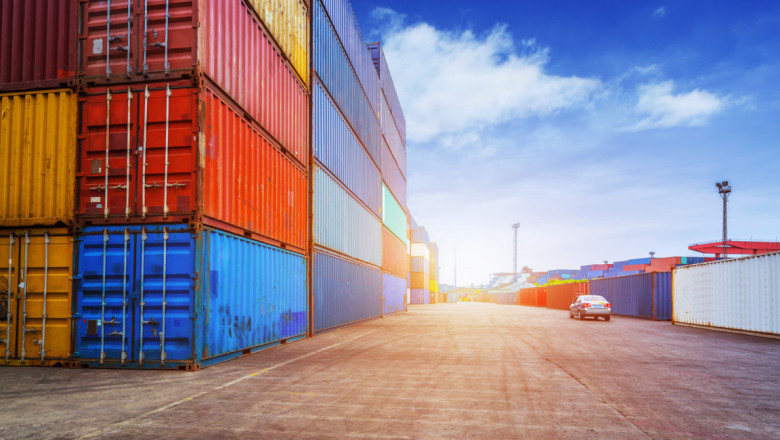views
The Evolution of Container Liners
With the steady growth of global trade over the past few decades, container ships have emerged as the primary mode of transport for cargo shipped between countries by sea. Starting in the 1950s and 60s, containerization allowed for faster and more efficient loading and unloading of cargo ships compared to traditional breakbulk methods. This led shipping companies to invest in specialized container ships called container liners to capitalize on the booming global trade.
The early Container Liner of the 1960s and 70s had a capacity of just a few hundred TEUs (twenty-foot equivalent units). However, advances in naval engineering enabled container ships to rapidly increase in size over the following decades. By the 1980s, panamax ships with capacities of 2,500-5,000 TEUs were common sights at major ports. In the 1990s and 2000s, the introduction of post-panamax and wide-beam container liners with capacities of 8,000-15,000 TEUs drastically increased the economies of scale for container shipping companies.
Today, the largest container ships can carry over 23,000 TEUs of cargo in a single voyage. Measuring over 400 meters in length, these ultra-large container vessels (ULCVs) represent the pinnacle of container shipping technology. Their massive economies of scale allow liner companies to offer very competitive freight rates to customers shipping cargo in large volumes between major trade routes.
Key Trade Routes Serviced by Container Liners
The backbone of global container liner networks are the busy East-West trade lanes linking manufacturing centers in Asia to consumer markets in North America and Europe. Some of the world's busiest container liner routes include:
- Transpacific (East Coast North America - East Asia): Major routes include China/Japan/Korea to US West Coast and US East Coast ports.
- Asia-Europe: Routes connect ports in China, Korea, Taiwan and Southeast Asia to destinations across Northern Europe. The main lanes include China/Korea - Northern Europe, Singapore/Malaysia - Northern Europe.
- Transatlantic (North America - Northern Europe): Major trade routes link US East Coast and US Gulf Coast ports to destinations across Northern Europe and the Mediterranean.
- Intra-Asia: Growing trade within Asia has boosted container volumes on intra-regional routes within East/Southeast Asia and the Indian subcontinent.
In addition to the fixed-day weekly sailings conventional on the above trades, several liner operators have also introduced string services with emphasis on excellence in supply chain velocity. These new services aim to transport cargo faster than the normal 20-25 days required to transport cargo between Asia and Europe/US.
Key Characteristics of Modern Container Liners
To efficiently service the high volume, time-critical liner trade routes, modern container liners are designed with certain key attributes:
Vessel Size - As mentioned earlier, economies of scale favor ultra-large container vessels above 18,000 TEU capacity. Their massive hold sizes allow vessel operators to maximize cargo utilization per sailing.
Speed - Container liners are powered by the latest generation slow-steaming bunker-efficient engines to maintain schedules. Speed ranges between 22-25 knots depending on vessel specifications and trade lane needs.
Cargo Handling Infrastructure - Onboard cranes, cargo holds, cell guides and hatches are optimized for fast loading/discharging of containers. Fully cellular containerships can load/unload multiple stacks of containers simultaneously using its complement of cranes.
Container Stowage & Lashing - Holds feature cell guides to stably stow containers in several vertically stacked tiers secured by automatic computer-controlled lashing systems. This ensures safe cargo transportation in all weather conditions.
ICT Systems - Advanced shipment management software integrates stowage planning, stability/load calculations and lashing optimization to maximize utilization of ship capacities. Vessels are also equipped with VSAT communications and automated reporting tools.
Reefer Plugs - To facilitate temperature-controlled transport of perishable cargo, modern liners offer hundreds to over two thousand reefer plugs distributed throughout holds. Plugs supply regulated electric power supply to plugged containers.
Bunkering Arrangements - Double hull structure meets stringent anti-pollution regulations. Recent 'eco-ships' also utilize advanced engine/hull technologies to minimize carbon footprint during transits. Dual-fuel engines allow liners to use cleaner LNG as an alternative fuel in some Emission Control Areas.
With newer classes of even larger 23,000+ TEU ULCVs set to join active fleets in coming years, container liners remain pivotal to maintaining fluidity of global supply chains in the decades ahead. Their seamless integration with wider logistics networks ashore ensures uninterrupted flow of cargo shipments powering international trade.
Get this Report in Japanese Language:
Get this Report in Korean Language:
About Author:
Alice Mutum is a seasoned senior content editor at Coherent Market Insights, leveraging extensive expertise gained from her previous role as a content writer. With seven years in content development, Alice masterfully employs SEO best practices and cutting-edge digital marketing strategies to craft high-ranking, impactful content. As an editor, she meticulously ensures flawless grammar and punctuation, precise data accuracy, and perfect alignment with audience needs in every research report. Alice's dedication to excellence and her strategic approach to content make her an invaluable asset in the world of market insights.
(LinkedIn: www.linkedin.com/in/alice-mutum-3b247b137 )






















Comments
0 comment